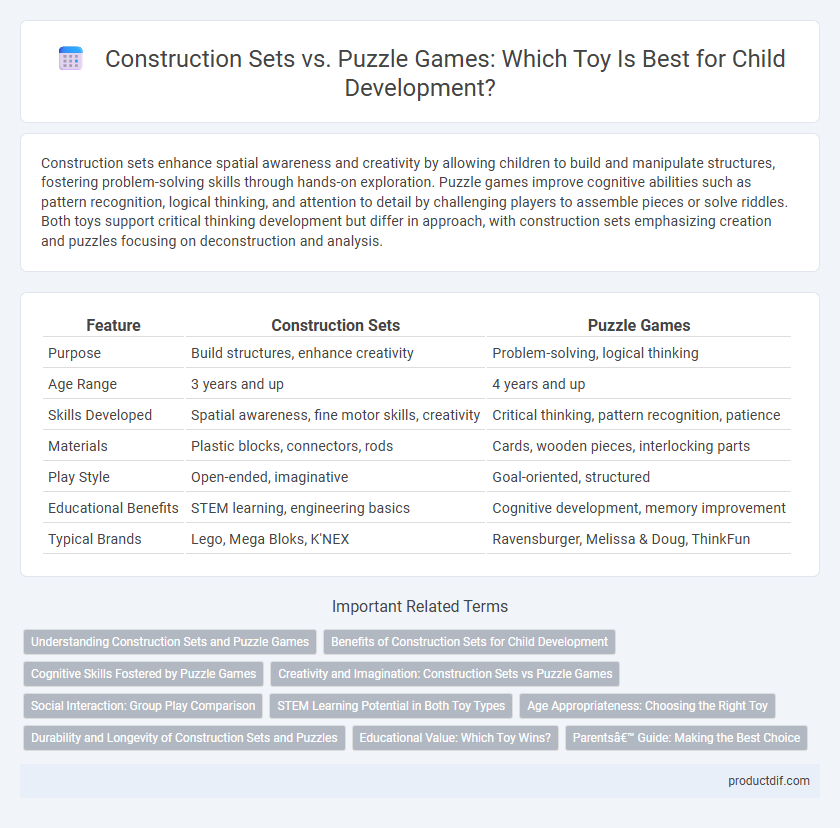Construction sets enhance spatial awareness and creativity by allowing children to build and manipulate structures, fostering problem-solving skills through hands-on exploration. Puzzle games improve cognitive abilities such as pattern recognition, logical thinking, and attention to detail by challenging players to assemble pieces or solve riddles. Both toys support critical thinking development but differ in approach, with construction sets emphasizing creation and puzzles focusing on deconstruction and analysis.
Table of Comparison
| Feature | Construction Sets | Puzzle Games |
|---|---|---|
| Purpose | Build structures, enhance creativity | Problem-solving, logical thinking |
| Age Range | 3 years and up | 4 years and up |
| Skills Developed | Spatial awareness, fine motor skills, creativity | Critical thinking, pattern recognition, patience |
| Materials | Plastic blocks, connectors, rods | Cards, wooden pieces, interlocking parts |
| Play Style | Open-ended, imaginative | Goal-oriented, structured |
| Educational Benefits | STEM learning, engineering basics | Cognitive development, memory improvement |
| Typical Brands | Lego, Mega Bloks, K'NEX | Ravensburger, Melissa & Doug, ThinkFun |
Understanding Construction Sets and Puzzle Games
Construction sets enhance spatial reasoning and engineering skills by allowing children to build complex structures with interlocking pieces, fostering creativity and problem-solving. Puzzle games improve cognitive abilities such as memory, pattern recognition, and critical thinking by challenging players to complete visual or logical tasks. Both toy types promote fine motor skills and mental development, but construction sets emphasize hands-on assembly, while puzzle games focus on strategic thinking.
Benefits of Construction Sets for Child Development
Construction sets enhance spatial reasoning and fine motor skills by allowing children to build and manipulate various shapes and structures. These toys stimulate creativity and problem-solving abilities, fostering cognitive development through hands-on experimentation. Unlike puzzle games that focus on pattern recognition, construction sets encourage open-ended play and engineering concepts, supporting STEM learning from an early age.
Cognitive Skills Fostered by Puzzle Games
Puzzle games enhance cognitive skills such as problem-solving, spatial reasoning, and critical thinking by challenging players to analyze patterns and strategize solutions. Unlike construction sets, which primarily develop fine motor skills and creativity through building, puzzle games require sustained concentration and memory retention, sharpening mental agility. These cognitive benefits make puzzle games effective tools for improving brain function and boosting intellectual development in children and adults alike.
Creativity and Imagination: Construction Sets vs Puzzle Games
Construction sets enhance creativity by allowing children to design and build unique structures, fostering spatial awareness and problem-solving skills. Puzzle games, while promoting logical thinking and pattern recognition, offer more structured challenges that limit open-ended exploration. Emphasizing imaginative play, construction sets encourage innovation, whereas puzzle games focus on completing predefined objectives.
Social Interaction: Group Play Comparison
Construction sets promote collaborative problem-solving and creativity, fostering communication and teamwork among children during group play. Puzzle games, while often played individually, can also encourage social interaction when solved cooperatively, enhancing shared goal-setting and patience. Both toy types develop critical social skills but construction sets more actively engage multiple participants in dynamic, hands-on collaboration.
STEM Learning Potential in Both Toy Types
Construction sets enhance STEM learning by promoting spatial reasoning, engineering skills, and creativity through hands-on building activities that encourage problem-solving and design thinking. Puzzle games improve critical thinking, pattern recognition, and logic by challenging players to analyze shapes and sequences, fostering cognitive development. Both toy types support STEM education by developing complementary skills: construction sets emphasize mechanical understanding and creativity, while puzzles focus on analytical skills and mental agility.
Age Appropriateness: Choosing the Right Toy
Construction sets like LEGO are ideal for children aged 5 and up, promoting spatial awareness and fine motor skills through building activities that match developmental stages. Puzzle games vary widely, with simpler jigsaw puzzles suitable for toddlers while complex logic puzzles engage older kids and teenagers, enhancing problem-solving and critical thinking abilities. Selecting age-appropriate toys ensures safety, maximizes educational benefits, and supports cognitive growth aligned with each child's capabilities.
Durability and Longevity of Construction Sets and Puzzles
Construction sets typically feature robust materials like high-quality plastic or wood, ensuring greater durability and the ability to withstand repeated assembly and disassembly. Puzzle games, often made from cardboard or thinner materials, tend to wear out faster, especially with frequent use. The long-lasting nature of construction sets makes them ideal for sustained play and development of fine motor skills over time.
Educational Value: Which Toy Wins?
Construction sets promote spatial reasoning, problem-solving, and creativity by allowing children to build structures, enhancing STEM skills. Puzzle games improve critical thinking, memory, and pattern recognition, fostering cognitive development through challenging tasks. Both toys offer distinct educational benefits, making the choice dependent on preferred learning outcomes in spatial versus logical skills.
Parents’ Guide: Making the Best Choice
Construction sets enhance spatial reasoning and creativity by allowing children to build and design structures using various shapes and connectors. Puzzle games develop problem-solving skills and cognitive flexibility through pattern recognition and logical thinking challenges. Parents should consider their child's developmental needs and interests, balancing hands-on creativity with critical thinking opportunities to make an informed choice.
Construction sets vs puzzle games Infographic

 productdif.com
productdif.com